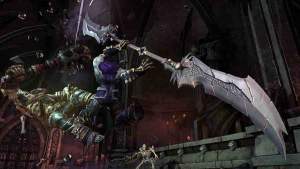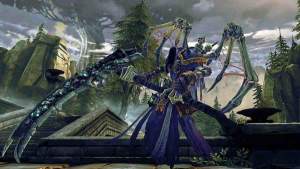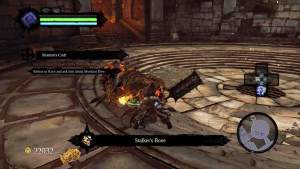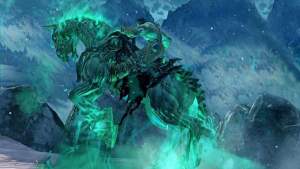His Review with Ian
Introducing Death.
He’s seeking the redemption of his brother War who’s been accused of the minor misdemeanour of sparking off the apocalypse. Darksiders II does not act as a direct sequel to Darksiders; it operates in and around the same time period but inside of focussing on War (like Darksiders), it follows his dexterous sibling and fellow horseman, Death who’s trying to clean the name and prove the innocence of his kin. As an idea overarching a gaming franchise, I think it could pave the way for at least two more games starring the leading men of Pestilence and Famine - I’m already visualising the epic epidemics following a Pestilence execution move.

The landscapes and scenographic design of the major environments and levels were carefully crafted to emphasise the relationship of Death to the world around him. When the world is grand in scale, high palaces dwarfed him. As he traversed the lush icy blue mountain ranges colour palette, it emphasised his own personal blackness; the consideration of the visual worlds and how the characters look and inhabit them was pleasing. The celebrated Jesper Kyd is on soundtrack and score duty and he knows how cater a composition to achieve maximum immersion and impact for players. His fantastical melodies and delicate themes are at the height of their powers with the cues entitled The Makers Theme and Into Eternity.

There were a few, consistent wobbly bits that happened throughout the game: the voice to mouth relationship and the synchronisation of some characters does not match even though it’s attempting too, the camera angle is profane inducing, especially when you’re backed into a corner and engaged in a bout of fine scythe to sword combat and my largest protest towards the amount of screen junk (numbers, blood, menus and options) that overload the screen - like a whole set of unnecessary road signs in a street – when I was occupied in battle showed a poor set of design choices.

Her Review with Tracey
Like most people I know, I reckon I have a healthy attitude towards death. It’s inevitable, necessary even and will hopefully come peacefully when I’m a wrinkly old lady (though I’m hoping to have my body cryogenically frozen before then). Death is not something I dread but not something I look forward to either, which is similar to how I have ended up feeling about Darksiders II. Despite having plenty of positives (drawing influences from a whole range of huge titles like Zelda, Enslaved and God of War), after the extensive campaign was over, I felt underwhelmed.

As a leading character, this physical manifestation of Death has a stereotypical pale skeletal, scythe wielding, ragged black winged aesthetic accompanied with a Pierce Brosnan-esque accent that is gravelly and Shakespearian yet lacking in either menace or charm. In traditional fiction, he isn’t the cause of death, more of an escort (that has often been tricked or bribed successfully by the likes of Bill and Ted, Rincewind or Gramps and Pud in the fabulous 1939 film On Borrowed Time) so I wondered if Death himself could be tricked by other characters or even die? Would having a leading videogame character that can’t die dramatically change the dynamics of any combat? Turns out this Death doesn’t die as such but rather passes out, and thankfully, following a slip off a wall into a pit of bloody spikes, respawning is pretty quick. Some of the bigger boss challenges are satisfying and frustrating in equal measure as many last for ages, requiring timed blows in repetitive, patterned sequences; great for testing personalised fighting technique and a player’s tenacity though sadly, often lacking in difficulty or so damn hard that it takes an age to advance. During battles, the quick respawn doesn’t count as Death is dumped before the cut scene and has to start over from the very beginning every time *groan*. Ian’s observation about ‘screen junk’ is particularly true during some of the bigger battles when all attention to detail is squandered. As blades leave hot coloured trails behind them, Death blurs into his opponents who always seem partially obscured by crazy camera angles or on screen displays. Smaller attacking opponents with heavy black character outlines are spewed out and smudged together from all angles, resulting in a melting of white pecs, linear bones, glowing eyes, scatty hair, glinting blades, pecking crows, zombie wraiths, broken paving slabs, floating red damage numbers, spectral life bars, twisting green wisps of health potions and erupting loot – it’s messy! Elsewhere, the animation is beautiful and it’s worth taking up some of the many side-quests. The characters of the Forge lands with their oversized hands and braided beards are particularly striking whilst the environments move from lush green open fields to colour drained rocky passages and dank dungeons.

Jesper Kyd’s evocative, cinematic score however is a masterful treat for the ears, shows real skill and is one of his best works to date. Emphatic long strings sweep over journeys as Destiny’s hooves match driving beats. A harp and dual pianos flow up and down musical scales during the water temple level whilst the fire temple has a steamy rhythm blazing through. The melodies as Death slickly glides across walls or scampers up beams never feels overpowering or monotonous but wondrous and perfectly balanced with impressive sound effects. This is definitely a game to experience through headphones.

Darksiders II is outu now for Xbox360, Playstation 3 and PC.